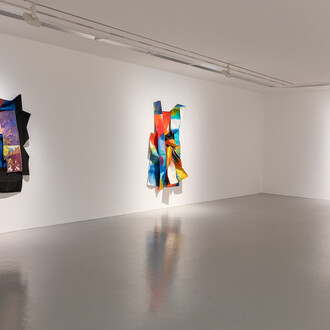The exhibition ‘Against the Enamel’ features a series of newly commissioned work by Portuguese artist Priscila Fernandes. The work references early 20th century art education, changing labour conditions, scientific discovery, anarchistic utopianism and spectacle. Fernandes grounds these influences together in a solo exhibition that takes its title from one of the most peculiar neo-impressionist paintings by Paul Signac - Opus 217. Against the Enamel of a Background Rhythmic with Beats and Angles, Tones, and Tints, Portrait of M. Félix Fénéon in 1890.
Intrigued by neo-impressionist technique and particularly by Paul Signac’s anarchistic Utopian vision and decorative propaganda, Fernandes attempts to activate once again this aesthetic language, which is derived equally from a study on the sciences of perception (as we would usually approach it), and an aesthetic gesture attacking social structures intended to inspire revolution. For this exhibition, Fernandes presents us with a LED video wall underlining the potentiality of form as action, with the backdrop of Signac’s painting spiraling continuously around its fulcrum.
Exposed under the eradiating beams of light from the video, five cast iron sculptures lay on the ground, as if in a reverent procession towards the explosion or implosion of the moving image. The sculptures shapes (inspired by primary art school manuals from the turn of the 20th century) and their materiality (cast iron), speak of an era when the focus on education and demands of labor were closely related. An era where industrial production promoted exercises intended to create working habits: a sense of effort, patience and perseverance in the students. Fernandes sees this approach towards the discipline as a moral, as well as aesthetic issue: the discipline of the hand that draws, is connected to the discipline of the body and moral conduct in general.
The industrial reference conveyed in the scultures creates an interesting parallel with the history of TBG+S, once used as a clothing factory (opened in 1932 by T.J. Cullen Limited). The site-specific intervention by the artist in the space exposes the original factory pillars allongside the supporting pillars of the 1990’s extension to the gallery, a symbolic gesture which tears back layers of time, evoking the buildings past and present use.
Curated by Rayne Booth
Priscila Fernandes (b.1981) is a Portuguese artist based in the Netherlands. She studied Painting at the National College of Art and Design (Dublin), followed by a Master in Fine Arts at the Piet Zwart Institute (Rotterdam). Her work has been recently included in exhibitions such as Learning for Life (Henie-Onstad Art Center, Norway); Abstract Possible: Stockholm Synergies (Tensta Konsthall, Stockholm); After the Future (EVA Biennial International, Limerick); Prix de Rome (Smart Project Space, Amsterdam); and in venues such as Museu da Electricidade (Lisbon); IMMA and The Lab (Dublin). She is the winner of the prestigious Prémio EDP Novos Artistas (Portugal), as well as receiving the Basicprijzen from Prix de Rome (Netherlands). In 2011, she was a guest-resident at the Rijksakademie (Amsterdam) and at IASPIS (Stockholm). Coming projects include the solo exhibition Lesson 0 at Fundació Joan Miró (Barcelona); Homo Ludens, at Museo Reina Sofia (Madrid); and 12 Contemporâneos, at the Contemporary Museum of Serralves (Porto). She is currently an artist in residency at Künstlerhaus Bethanien, with a grant from Gulbenkian Foundation (PT).
This exhibition is kindly supported by the Mondriaan Fund, Netherlands, and by the residency programme at the Irish Museum of Modern Art.
All images, Against the Enamel, Installation. Video animation on LED wall, cast iron sculptures and removal of cladding from pillars, 2014. Video animation is based on: Signac, Paul (1863-1935): Opus 217. Against the Enamel of a Background Rhytmic with Beats and Angles, Tones and Tints, Portrait of M. Felix Feneon in 1890 (1890). New York, Museum of Modern Art (MoMA). Oil on canvas, 29 x 36 1/2' (73.5 x 92.5 cm). Fractional gift to the Museum of Modern Art, New York, from a private collector. © 2013. Digital image, The Museum of Modern Art, New York/Scala, Florence. Photography by Kasia Kaminska











![Jonathas de Andrade, 4000 disparos [4000 shots], 2010, super-8 transferred to DVD, 60’ loop. Courtesy the artist & Galeria Vermelho](http://media.meer.com/attachments/35f0c50a7513b336ad6c9e4a7163138acfa8264b/store/fill/330/330/73a6ab949d4336a9a2d736541515aa070e2dc6d96f684409b76c050c6edc/Jonathas-de-Andrade-4000-disparos-4000-shots-2010-super-8-transferred-to-DVD-60-loop-Courtesy.jpg)







